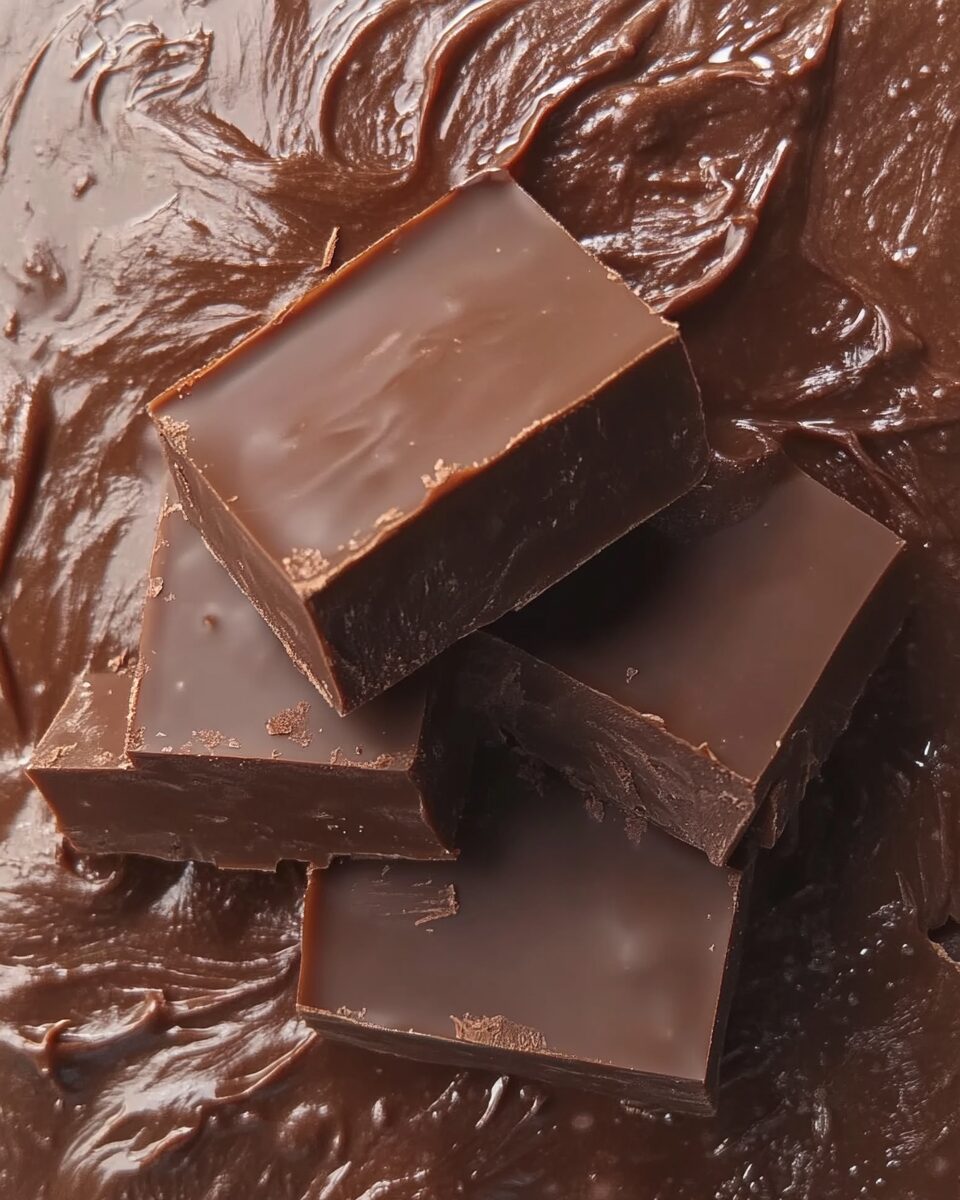This Milk Chocolate Fudge is a rich and creamy dessert that’s incredibly easy to make. With just two ingredients, it’s perfect for satisfying your sweet tooth or gifting to friends and family. Whether you’re a novice or experienced in the kitchen, this recipe is straightforward and yields delicious results.
Full Recipe:
Ingredients
- 3 cups (18 oz) milk chocolate chips or chopped milk chocolate bars
- 1 (14 oz) can sweetened condensed milk
Directions
Microwave Method:
- Line an 8-inch square baking pan with parchment paper.
- In a microwave-safe bowl, combine the milk chocolate and sweetened condensed milk.
- Heat on 70% power for 90 seconds.
- Let the bowl sit in the microwave for 3 minutes.
- Remove and stir until smooth and creamy.
- If necessary, heat for an additional 15 seconds at 70% power, then stir again.
- Pour the fudge into the prepared pan, cover, and refrigerate for 2–3 hours until firm.
- Once set, remove from the pan and cut into squares.
Stovetop Method:
- Line an 8-inch square baking pan with parchment paper.
- In a medium saucepan over low heat, combine the milk chocolate and sweetened condensed milk.
- Stir occasionally until about 75% of the chocolate has melted.
- Remove from heat and continue stirring until smooth and creamy.
- Pour the fudge into the prepared pan, cover, and refrigerate for 2–3 hours until firm.
- Once set, remove from the pan and cut into squares.
Nutritional Facts (per serving, based on 36 pieces)
- Calories: 149 kcal
- Carbohydrates: 19g
- Fat: 8g
- Saturated Fat: 5g
- Sodium: 0.03mg
- Potassium: 85mg
- Sugar: 17g
- Calcium: 21mg
Why Milk Chocolate Fudge Is So Irresistible
One of the main reasons milk chocolate fudge is so beloved is its unique combination of flavors and textures. The milk chocolate provides a sweeter, creamier taste compared to dark chocolate, which can sometimes be more bitter or intense. This makes milk chocolate fudge approachable for all ages, from children to adults.
The texture of fudge is another factor that draws people in. It’s dense and smooth, yet slightly crumbly, providing a melt-in-your-mouth experience that is deeply satisfying. The use of sweetened condensed milk adds richness and moisture to the fudge, preventing it from being dry and enhancing its creamy consistency.
Versatility of Milk Chocolate Fudge
Milk chocolate fudge is incredibly versatile and can be adapted in countless ways to suit different tastes and occasions. While the basic recipe is wonderfully simple, you can add nuts like pecans or walnuts for a delightful crunch, swirl in caramel or peanut butter for extra flavor complexity, or top with sea salt to balance the sweetness.
This flexibility makes milk chocolate fudge a fantastic base recipe for experimenting in the kitchen. It can be dressed up for special occasions or kept straightforward for quick homemade treats. Moreover, fudge can be easily portioned and wrapped individually, making it perfect for parties, holiday gift baskets, or sharing with friends.
The Science Behind Fudge Making
Understanding a bit about the science behind fudge helps explain why it’s so important to follow certain techniques during preparation. Fudge is essentially a type of candy that relies on controlled crystallization of sugar. When heated and cooled properly, sugar crystals form in a way that creates the fudge’s signature creamy texture.
Milk chocolate fudge uses sweetened condensed milk, which contains sugar and milk solids that contribute to this crystallization process. The chocolate melts and blends with the milk solids, while the sugar forms tiny crystals as the fudge cools and sets. Stirring the fudge at the right moment helps ensure these crystals are small and uniform, resulting in that smooth, creamy mouthfeel.
If the fudge is overheated or cooled too quickly, it can become grainy or too hard. That’s why temperature control and timing are key factors in achieving perfect fudge every time.
Nutritional Considerations
While milk chocolate fudge is undeniably delicious, it is important to be mindful of its nutritional content. Fudge is a concentrated source of calories, sugars, and fats, which makes it a treat best enjoyed in moderation. The primary ingredients—milk chocolate and sweetened condensed milk—are both rich in sugars and fats.
That said, fudge can fit into a balanced diet when consumed occasionally as a special treat. Some homemade fudge recipes allow you to control the quality of ingredients used, opting for higher-quality chocolate or less processed sweetened condensed milk, which may slightly improve the nutritional profile.
Additionally, there are creative ways to make fudge a little healthier by incorporating nuts or seeds for added fiber and nutrients, or experimenting with sugar substitutes. However, the classic recipe remains a delicious indulgence worth savoring thoughtfully.
Cultural Significance and Traditions
In many cultures, fudge is more than just a dessert—it is a symbol of celebration and sharing. Particularly in the United States, fudge shops are popular tourist attractions in places like Florida, Maine, and Vermont, where visitors often buy various flavors as souvenirs.
During holidays such as Christmas, fudge is frequently made in large batches to share with family and friends, embodying the spirit of togetherness. Many people also gift homemade fudge as a heartfelt present, often packaged beautifully in decorative boxes or tins.
The act of making fudge can also be a social tradition, bringing loved ones together to cook, chat, and enjoy each other’s company. It’s a simple recipe that invites creativity, conversation, and connection.
Tips for Perfect Milk Chocolate Fudge Every Time
Achieving the perfect milk chocolate fudge might seem intimidating at first, but with a few helpful tips, anyone can master it. First, always use good quality milk chocolate. The flavor and texture of your fudge depend heavily on the chocolate you choose.
Second, be patient with the cooling and setting process. Proper chilling time in the refrigerator is crucial for the fudge to firm up to the ideal texture for cutting and serving.
Third, don’t rush the stirring. Stirring until the mixture is fully smooth ensures even crystallization and a creamy finish.
Lastly, experiment! Try adding different flavorings like vanilla extract, espresso powder, or even a pinch of chili powder for an adventurous twist.
How to Serve and Store Milk Chocolate Fudge
Milk chocolate fudge is best served at room temperature, allowing its creamy texture to shine. It pairs beautifully with a hot cup of coffee or tea, making it a great after-dinner treat or snack.
When storing fudge, keep it in an airtight container in the refrigerator to maintain freshness and prevent it from drying out. Properly stored, fudge can last up to two weeks in the fridge. For longer storage, fudge freezes well—just wrap it tightly and thaw at room temperature before enjoying.
Conclusion
Milk chocolate fudge is a timeless dessert that perfectly balances simplicity, richness, and versatility. Its creamy texture and sweet, smooth flavor make it a favorite treat for people of all ages. Beyond just a tasty indulgence, fudge carries with it a history steeped in tradition and celebration.






